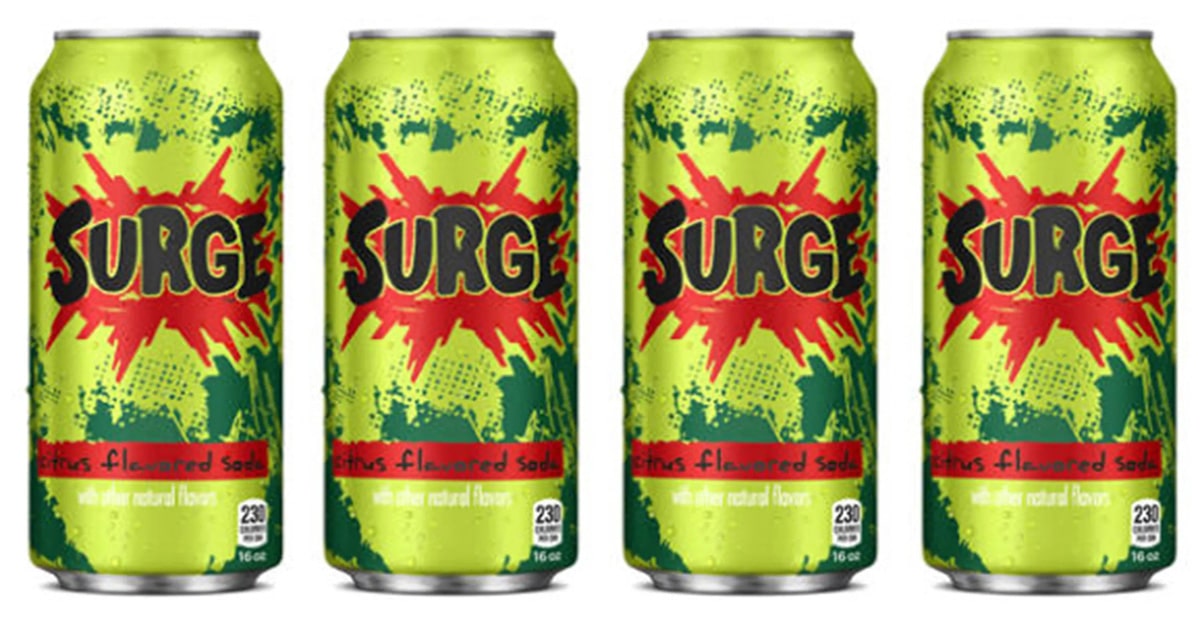Surge Soda
For years, soda products were promoted as being good for you. Before research into the damaging effects of consuming too much sugar, kids and adults alike treated soda like it was a good trade for water. Those were the days.
One of the classic flavors for soda products has always been lemon-lime or citrus, and there have been many sodas that have come and gone in this space. Nearly all of the lemon-line or citrusy sodas that have been made by major corporations have ended up being pulled from production, and Surge Soda is no different. It turns out that this market space is not as big as one might think, and competition with traditional citrus sodas is often too fierce for newcomers to make a go of it long-term.
Please leave a review or any memories of this snack in the comments at the bottom of this page. Thank you!
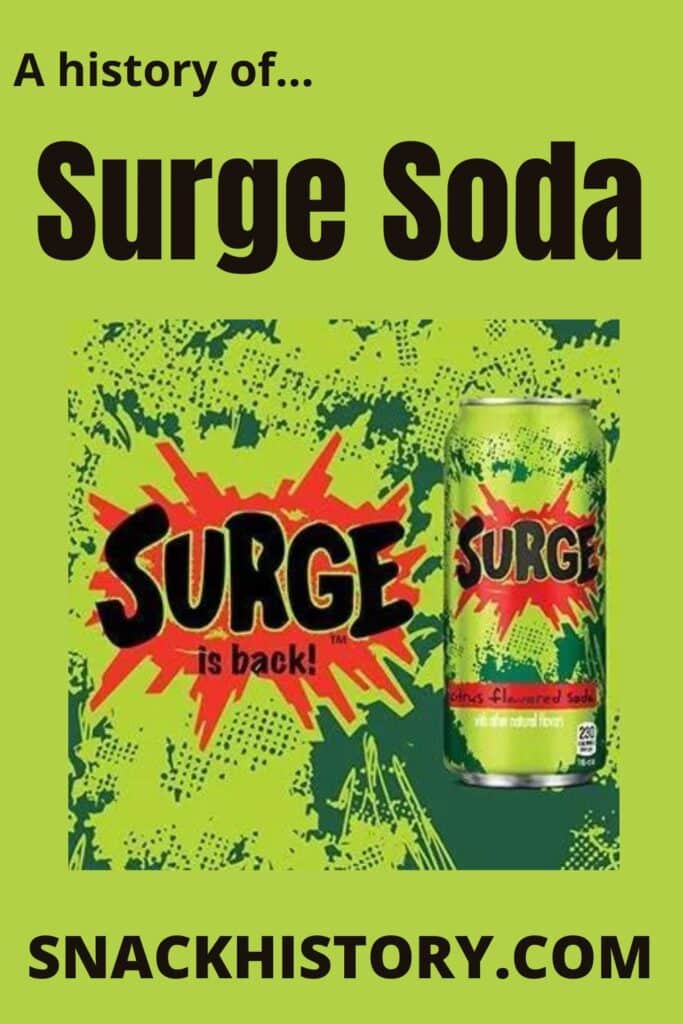
History
Surge Soda was the perfect summation of all things the 1990s. It came in colorful green and red bottles, and it was marketed heavily toward kids. The idea behind the creation of this lemon-lime and citrus soda was for Coca-Cola to carve out a big dent in the citrus soda niche. They had cornered the dark soda niche for years but clearly felt it was time to move into new territory.
And so, Surge was born to compete with Pepsi’s Mountain Dew and other sodas like 7-Up. Every child or teen who experienced the 90s remembers all of the snack and drink products that were made with bizarrely bright colors and truly insane advertising. Surge fit every single one of the requirements for a snack product in the late 90s, from the atomic green color to the nutty ads that were made to promote it.
Surge Soda actually performed really well at first. By the late 90s, it was selling better than many other kinds of citrus sodas that were supposed to “wake you up!” and make superhuman feats possible. This was the era before Red Bull and other energy drink products. Consumers could have coffee or load up on sugary soda if they wanted to wake up and get going.
Surge Soda might even have made it in the long run, but the marketing department at Coca-Cola was handed over to Charles S. Frenette. Frenette was well-known for being conservative and having a very different view of marketing soda products from his predecessor. All Coca-Cola stocks plummeted shortly after he took control of the marketing team. Surge was one of the first products to lose value and cease to sell.
On top of the change in marketing strategy, there started to be rumors that Surge Soda could cause adverse effects related to its high sugar content and high caffeine content. From the perspective of consumers who have been gobbling up energy drinks for most of their life, this probably seems very silly. However, in the late 90s, fears over what sugar and caffeine could do to you were highly popularized by the media, and parents, in particular, were very scared of the effects of these substances on their kids.
Just like lots of other snacks and sodas, Surge Soda was blamed for kids being unable to sit still at school and for children acting out or being emotional. Research into the actual effects of sugar and caffeine was years away, but the media didn’t care. Colorful and wacky products of all kinds vanished from the shelves of stores, much to the dismay of kids everywhere.
Coca-Cola had not given up on the dream that was Surge Soda, however, and they released a product called VAULT in 2005. Lovers of Surge were not impressed, and the product limped along with mediocre sales for some time. By 2011, it was clear to Coca-Cola that VAULT needed to go, and it was finally discontinued.
Enter the Surge Movement. Facebook makes all kinds of things possible that would never have happened in a world without social media. Lovers of Surge Soda gathered under the banner of the Surge Movement Facebook page in 2011 to demand that Coca-Cola bring back the soda. The idea of the group was to make sure the soda was actually profitable this time so that it never went away.
The Movement actually gathered a lot of steam, collecting thousands of members and lots of discussion. Fundraisers were hosted, and crowdfunding was put to work. Coca-Cola, clearly impressed with the efforts of passionate fans, joined the conversation.
As a result of the efforts of some Facebook-utilizing fans with deep loyalties to Surge, as of 2018, Surge is now available in Coca-Cola Freestyle machines and exclusively offered at Burger King. There are flavors of the soda now as well, and you can choose from Cherry, Grape, Vanilla, and Zero Sugar, along with the original citrus flavor.
Burger King also makes Frozen Surge as a limited-edition slushy. This slushy product comes back from time to time and occasionally makes its way into corner stores at Valero gas stations as well. Cinemark theaters also were able to distribute the slushy product in 20017 for a short time, calling it Surge Frozen.
It’s not clear if Surge will survive well into the future like the Surge Movement creators desired. However, for the moment, the supply is kept stocked in Burger King locations, and you can often find it for sale online.
Marketing
In the early days, Surge was marketed to appeal almost exclusively to older teens. Most of the classic ads that people remember best, included someone setting up an obstacle course of some kind and then reverently placing a can of Surge at the end of the gauntlet. This person would then yell, and the participants in the race would crash, climb, fight, and leap to get to the Surge at the end of the gauntlet.
Classic commercials showed people climbing over couches, running down slippery and wet hallways, and fighting tooth and nail to be the one to claim the Surge bottle at the end of the race. This Mad Max-style commercial clearly connected with kids, and Surge was a big hit during the years when the advertising slogan for the soda was , “Feed the Rush”.
At this time, music videos and TV commercials all had a similar vibe to them, and kids from the 90s remember how much these low-light, high-action bits of content really connected with them. There was something mysterious and totally inspiring about this kind of content, and kids responded to the zany ads for Surge with enthusiasm.
Logo
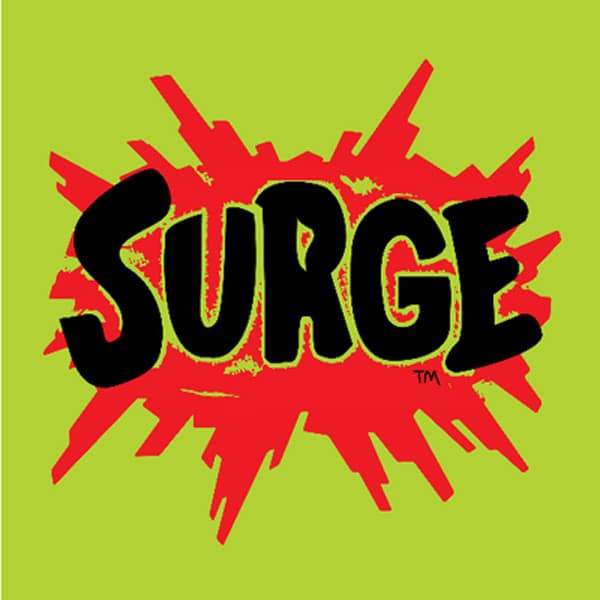
Surge Movement
The Surge Movement began on Facebook in 2011. By 2012, the 11,000 fans of the Surge Movement page created a crowdsourcing campaign through Indiegogo. This led to a billboard ad that showed the tagline, “Tell Coke you want it back in the loudest way possible!”
By 2013, the crowdfunding event had managed to raise its goal of $3,745. Another billboard was set up about a half mile from Coke’s headquarters. This ad read, “Dear Coke, we couldn’t buy SURGE, so we bought this billboard instead”.
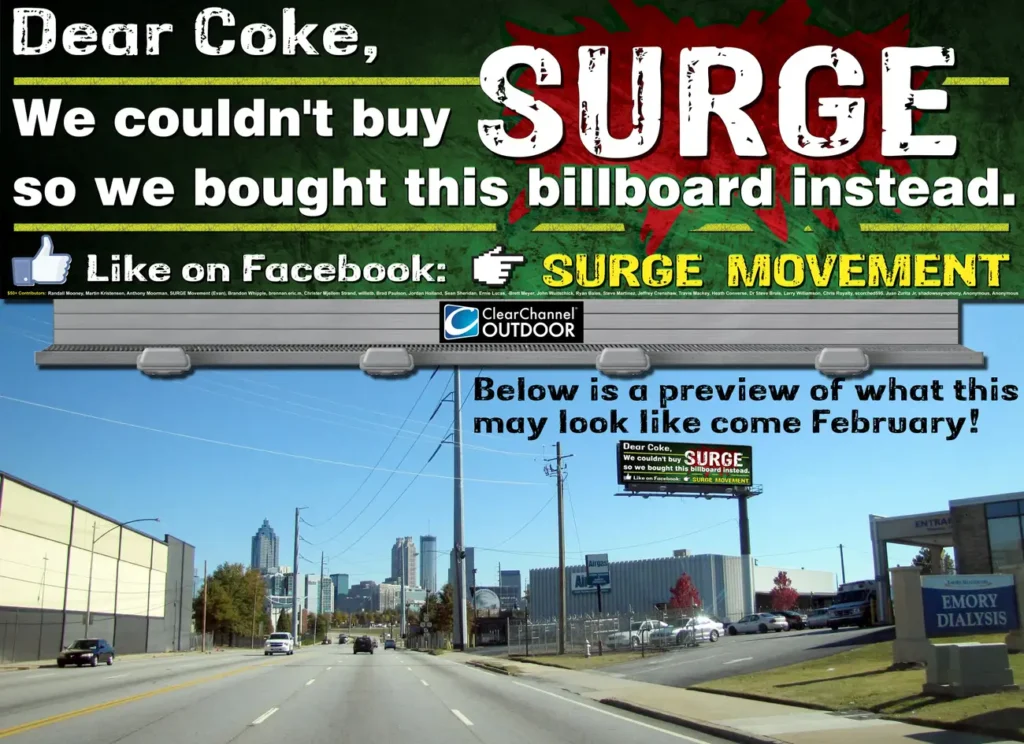
The community responsible for this feat became newsworthy, and the team appeared on CNN Money, Business Insider, and Yahoo! News. Buzzfeed even picked up the story and ran with it. This was an iconic moment in the Surge Movement’s history and one that helped to get the attention of Coca-Cola executives.
The Movement created the “Syrup Fundraiser” later in the same year, sending out a total of 525 Surge syrup samples for $20 apiece to households all over the nation. This was possible because they had collected the contents of a few remaining Surge soda fountain syrup boxes. Those who bought the syrup packets could make Surge with 10 oz of club soda or keep the packets for posterity.
This fundraiser was another big hit, and the syrup packets sold out in just six hours. The fundraiser combined with Mercy Outreach during the process of distributing the syrup packets, creating a secondary and very helpful fundraising opportunity for fans.
The Movement compiled a multi-page proposal for Coca-Cola in 2014. They stated that they wanted to work cooperatively on reviving the soda. The proposal was sent as an email to the executives at Coca-Cola, who replied very quickly to state that they were working on a plan to bring back the soda. Hundreds of people breathed a sigh of relief that their efforts of three years had finally come to fruition. Surge Soda would be back on shelves to be enjoyed again by those who loved it most.
Ingredients
- Carbonated water
- High fructose corn syrup
- Maltodextrin
- Citric acid
- Natural flavors
- Orange juice concentrate
- Potassium benzoate (to protect taste)
- Potassium Citrate
- Caffeine
- Calcium disodium EDTA (to protect taste)
- Yellow 5
- Yellow 6
- Carob bean gum
- Blue 1
Nutrition
| Serving Size: | 1 can | % Daily Value* |
| Amount Per Serving | ||
| Calories | 170 | |
| Total Fat | 0g | 0% |
| Sodium | 40mg | 2% |
| Total Carbohydrates | 46g | 17% |
| Sugars | 41g | |
| Protein | 0g |
Varieties
- Original
- Surge Grape Glory
- Surge Cherry Rush
- Surge Vanilla Vibe
- Zero sugar
Pictures
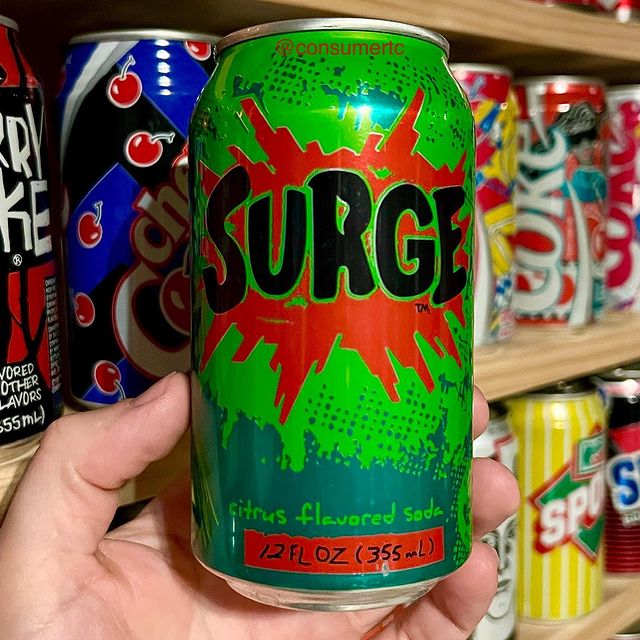
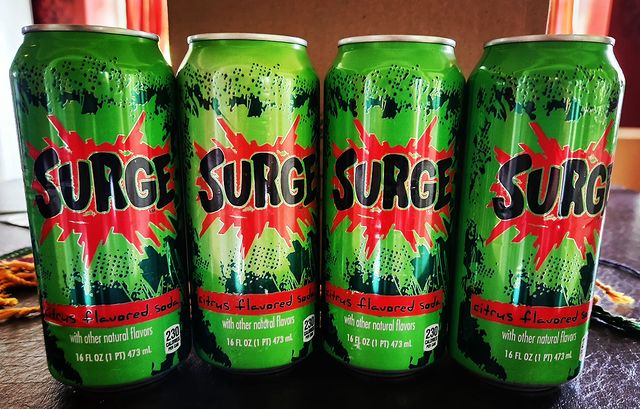
Ads:
A 1997 ad for Surge Soda that many people saw and remember even today. Who wouldn’t remember mosh-pit, American Ninja Warrior style battles for a soda bottle?
The Surge Soda plane ad from 1998:
A classic “Feed the Rush” slogan commercial:
Jason has been a snack addict since his early years and now enjoys nothing more than reviewing his favourite candys and sweets.
Please leave a review or any memories of this snack in the comments below. Thank you!
Click here for a full A-Z list of Snacks and Candy
